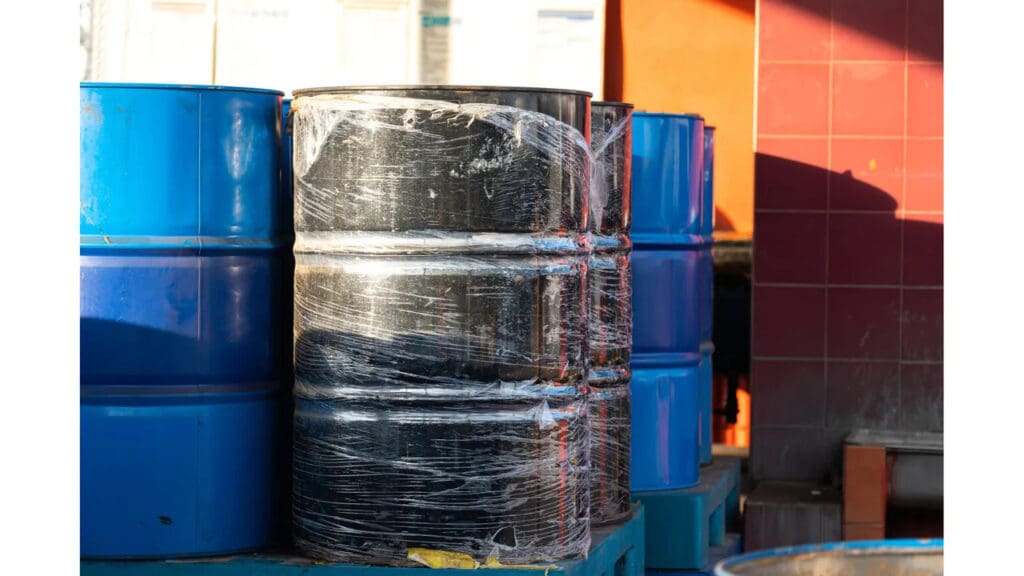DOT Compliant Drum Disposal: How Elk Environmental Safely Manages Residual Waste
- Waste Management

Key Takeaways
- 55-gallon waste drums pose risks if not properly managed, including leaks, structural failure, and compliance violations.
- High summer heat can cause bulging or over-pressurization, increasing risks if not addressed promptly.
- Elk Environmental follows a multi-step process that includes an inventory profile, inspection, manifest, removal, and transportation.
- Non-compliant drums require over-packing or re-containerization before being moved.
- Every step is aligned with EPA RCRA regulations, OSHA hazard communication standards, and DOT transport requirements.
Proper drum disposal is not just a regulatory requirement. It is a critical practice for workplace safety, environmental responsibility, and business reputation. Chemical residues left in 55-gallon drums can create fire, health, or pollution hazards if mishandled, and violations or incidents can also lead to higher insurance costs for businesses, according to the EPA.
Since 1988, Elk Environmental has been a trusted partner for companies in Pennsylvania and the Mid-Atlantic region. Our compliant drum disposal process reflects more than 35 years of experience in residual waste (hazardous and non-hazardous), field services, and transportation logistics. By following governmental standards, Elk ensures every drum is handled with safety and compliance in mind.
Why 55-Gallon Drums Require Specialized Handling
At first glance, a 55-gallon drum may look like a simple steel, fiber, or poly container. In reality, it’s one of the most regulated units in industrial waste management. Drums can contain hazardous materials such as flammables, corrosives, or toxic residues that fall under the Resource Conservation and Recovery Act (RCRA). RCRA, first enacted in 1976, requires cradle-to-grave oversight of hazardous waste, including storage, transportation, disposal, profile, and manifesting.
Even non-hazardous drums can pose risks. Residual chemicals may react with each other, leading to pressure build-up or leaks. Improper labeling or degraded container integrity can also lead to violations of OSHA’s Hazard Communication Standard, which mandates that all workers be informed of chemical hazards. Without specialized handling, businesses risk both environmental harm and costly fines from regulators.
Step-by-Step: Compliant Drum Management Process
1. Drum Inventory and Assessment
Elk begins by cataloging each drum on site (fiber, steel, or plastic), with our team recording the identification details and verifying labels. According to the EPA’s hazardous waste generator requirements, accurate waste characterization is the first step in compliance. Elk’s trained staff performs waste characterization to determine if the materials in the drum are hazardous or non-hazardous, which ultimately determines where and how we transport and dispose of the drum.
2. Inspection Protocols
Once inventoried, each drum is visually inspected for dents, corrosion, leaks, or bulging. Visual inspections of the drums are performed to confirm that the container is structurally sound. Labels are cross-checked against DOT’s Hazardous Materials Regulations, which require proper hazard communication and manifesting on all shipped containers. If a drum fails inspection, it is deemed not “compliant” and flagged for repackaging or over-packing before transport.
3. Safe Removal Techniques
Elk’s field crews—trained under OSHA’s HAZWOPER standard—use appropriate PPE, drum-handling equipment, and spill-prevention controls during removal. Each site is treated as a potential high-risk environment, with emergency response plans in place in case of leaks or ruptures. This ensures that removal not only complies with federal guidelines but also minimizes real-world risks to workers and the environment.
4. Transportation Logistics
Once cleared, drums are loaded into DOT-licensed, compliant vehicles equipped with spill-control equipment. Elk maintains strict manifest documentation, as required by EPA, PADEP, and U.S. DOT regulations. This ensures that liability for the waste is fully documented from pickup through final disposal at licensed facilities.
Handling Hazardous vs. Non-Hazardous Materials
Not all drums require the same disposal pathway. Hazardous drums—those containing ignitable, corrosive, reactive, or toxic substances—must be managed at TSDFs (treatment, storage, and disposal facilities) or licensed hazardous waste facilities, and be transported and disposed of in UN-approved containers. Elk chemists have the experience and expertise to perform safe and efficient lab packing. They use absorbents and specialized transport to ensure these materials are neutralized or destroyed in compliance with EPA and state regulations.
Non-hazardous drums may still require special handling, especially if residues can pose environmental concerns. For example, the NOAA Chemical Response database guides managing substances that aren’t formally classified as hazardous but still present risks. Elk applies these standards to ensure even “low-risk” waste is responsibly managed.
What If Drums Are Not Compliant?
Not every drum passes inspection. Some may show severe rust and leaks, or be missing labels, lids, and bungs. In these cases, Elk performs re-containerization: placing the compromised drum inside an over-pack or transferring the contents to a compliant container. This process ensures compliance with DOT’s packaging regulations and prevents unsafe drums from entering transport. Clients benefit from reduced liability and peace of mind that all materials are moved safely.
Summer Heat and Over-Pressurized Drums
Seasonal weather can turn a routine pickup into a safety hazard. In hot summer conditions, chemical residues expand and cause drums to bulge or “pop.” The OSHA Technical Manual warns of pressure build-up in sealed containers exposed to heat, which can result in violent ruptures. Elk advises generators to schedule removals proactively during the summer months and to flag any drums showing signs of swelling. By taking early action, businesses reduce the risks of injury, spills, or costly emergency response.
Why Elk’s Approach Stands Out
Elk Environmental isn’t just a waste transporter. It’s a full-service environmental partner. From the initial drum assessment to final disposal, Elk delivers turnkey service that emphasizes safety, compliance, and environmental stewardship. With over 35 years of serving Pennsylvania and the Mid-Atlantic, Elk has built relationships with regulators, disposal facilities, TSDFs, and clients that allow us to move quickly while keeping costs manageable. Choosing Elk means gaining confidence that your waste is handled by experts who know both the regulations and the risks.
If your facility needs expert help with drum disposal, contact Elk Environmental today for a consultation or quote.
For more information:
